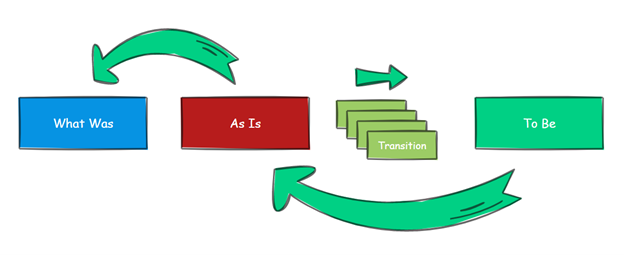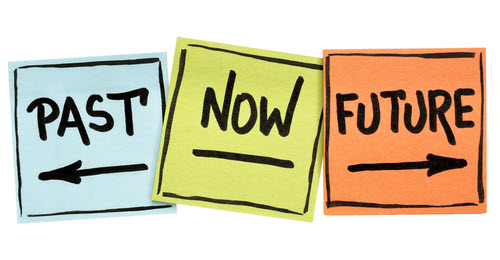As Enterprise Architects our job is to focus on understanding the “As Is” and building transition plans to get to the “To Be”. But I always like to remind people don’t forget the “What Was”. We can learn from our past experiences if we do the due diligence to track our change in a managed way. This article will give my perspective on that process.
Ask anyone in your organization and they can quickly tell you what the issues and concerns are with the way things are done today in the “As Is” model. Ask them to describe how it should be and you get a lot of feedback on how perfect it will be in the “To Be”. What you will not get is a lot of conversation about what should the first few steps of the transition should be. We need to develop the transition architecture and plans to get from “As Is” to “To Be”. It’s common sense but harder to do than you think. But in making those plans don’t forget the “What Was”. As we transition our architecture, over time the “To Be” will become the “As Is” and the “As Is” will become the “What Was”.

A few years ago, I was tasked to lead an effort to do an SAP ERP upgrade. At the time I knew how to spell SAP but that was about it. But I did know how to manage successful migration efforts and I had a talented team to work with. The first thing I did was collect all the lessons learned that had been captured from past migrations. I went through them to understand past issues and watch-outs. I then cleansed the list as best I could and presented it to the team. They were pleasantly surprised by my efforts. One of the Senior Leads said in all her years of doing upgrades no one had ever thought to do this exercise. She said they always did a lesson learn task after each migration but no one had ever thought to go back and review the past lessons learned. I asked why they did them every time then? She replied with the age-old response, to check the Project Management box of tasks completed. This is one of my personal key architecture principles. The action should not be greater than the intent. How many times have we seen tasks being done and no one really remembers why we are doing them? Make sure we get value from the effort we put in by remembering why we are doing it in the first place.
I told the team the best weapon I had to offer the project was my ignorance. I did not know much so I would rely on past efforts through well-documented lessons learned and I would ask lots of questions to make sure we were all clear on the tasks and outcomes. As the migration got underway, we found more than one instance when my lessons learned exercise paid off. We had anticipated some of the potential issues and were ready to mitigate the problems before they stalled our efforts.
We did run into a roadblock however even with all our due diligence. The team was stumped as to why we could not bring the system back up. We tried all we could based on the knowledge of the team. Eventually, we discovered that the underlying database was out of disk space. We fixed the issue and were able to complete the migration on time. We made sure to highlight this as a future watch out for the next migrations during our now valuable post-migration lessons learned exercise.
A few years later I had moved on but one of the SAP team members reached out to me to say that they had adopted the task of lessons learned review as the first step in their project planning. Sure enough, they saw our note on ensuring that they check for enough disk space before they bring the system back up. This review effort saved them time as they were able to quickly remediate the effort before it became an issue.
As part of your architectural and project plans make sure you document and publish lessons learned. Capture and classify architectural decision documents. Define technical debt trade-offs and ensure that they are given visibility for a governance review in a timely fashion. Those who forget the past are doomed to repeat it. The “To Be” will become “As Is” and the “As Is” will become the “What Was”. Do not lose all that valuable history as you transform your Enterprise.
